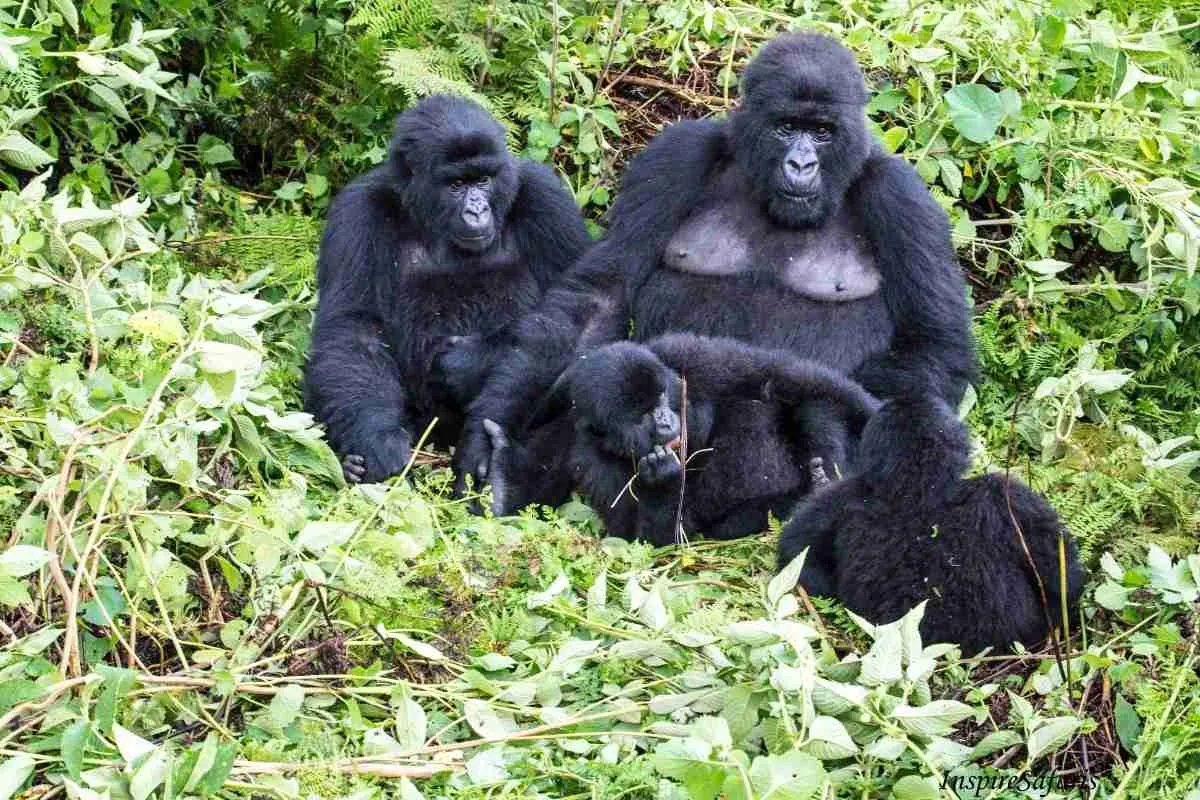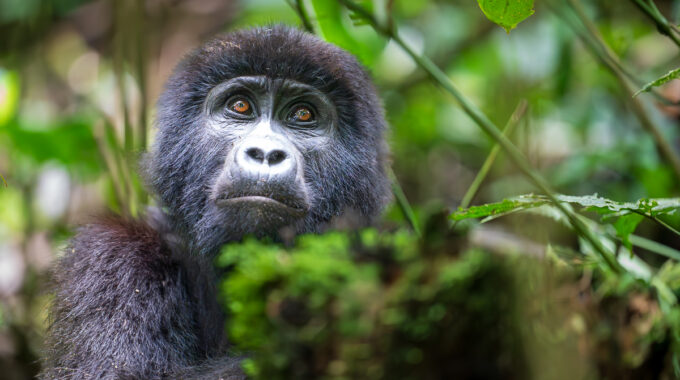Volcanoes national park, Bwindi gorilla park, and Mgahinga Gorilla National Park—Community Involvement in Park Conservation…
Flora and Fauna Beyond Gorillas
Flora and fauna in Rwanda and Uganda: Discovering Rwanda and Uganda’s Hidden Treasures

Flora and fauna in Rwanda and Uganda: When most travelers think of gorilla trekking in Rwanda or Uganda, the majestic mountain gorilla is the star attraction. But beyond the dense forests where these gentle giants roam lies a vibrant world teeming with incredible biodiversity. The ecosystems of Volcanoes National Park, Bwindi Impenetrable Forest, Mgahinga Gorilla National Park, and Nyungwe Forest National Park host an astonishing array of flora and fauna that make every trek, hike, or nature walk an adventure of its own.
This blog explores the often-overlooked but equally captivating plant and animal life found in the gorilla trekking regions of Rwanda and Uganda, offering insight into what makes this part of East Africa one of the most biologically rich regions on the planet.
The Unique Ecosystems of Rwanda and Uganda
The Albertine Rift—where most of the gorilla habitats in Rwanda and Uganda are located—is known as a global biodiversity hotspot. The steep elevations, volcanic soils, and tropical climate create an environment where both endemic and endangered species thrive.
Flora and fauna in Rwanda and Uganda: These areas are more than just gorilla sanctuaries; they are living museums of evolutionary history and ecological complexity.
Flora: The Botanical Wonders of the Forests
1. Afro-Montane Vegetation
The gorilla parks, particularly Bwindi and Volcanoes National Park, feature afro-montane vegetation, characterized by dense forests, bamboo zones, and high-altitude moorlands.
Some common and fascinating plant species include:
- Giant Lobelias: Towering, alien-like plants that dominate the high-altitude zones.
- Hagenia Abyssinica: A flowering tree used in traditional medicine and known for its pink and red blossoms.
- Bamboo Forests: Especially common in Volcanoes National Park, this zone is not only beautiful but also a primary food source for mountain gorillas.
- Tree Ferns: Ancient plants that give parts of Bwindi an almost Jurassic feel.
These forests are a paradise for botany enthusiasts, photographers, and travelers interested in medicinal and cultural plant uses.
2. Medicinal Plants
Local communities surrounding the parks have long used the forests as pharmacies. Plants like Prunus africana, used for treating prostate conditions, and Warburgia ugandensis, used for respiratory issues, are just a few examples of ethnobotanical knowledge passed down through generations.
Fauna: Wildlife Beyond the Gorillas
1. Primates Galore
While mountain gorillas are undoubtedly the highlight, the forests of Uganda and Rwanda are home to several other primate species:
- Golden Monkeys: Endangered and found in the bamboo forests of Mgahinga and Volcanoes National Park.
- L’Hoest’s Monkeys: A rare species that prefers the undergrowth of highland forests.
- Colobus Monkeys: With their striking black-and-white fur, these monkeys are a common sight in Nyungwe Forest.
- Chimpanzees: Especially found in Kibale Forest National Park in Uganda and Nyungwe in Rwanda.
These primates are often active, social, and easy to spot, offering enriching encounters for trekkers who take time to observe the forest layers.
2. Birds: A Birder’s Paradise
Uganda and Rwanda are both considered top birding destinations in Africa. With over 1,000 bird species between the two countries, including numerous Albertine Rift endemics, the regions offer world-class birdwatching.
Must-see birds include:
- Great Blue Turaco
- Ruwenzori Turaco
- African Green Broadbill (found only in Bwindi)
- Shoebill Stork (found in Uganda’s wetlands)
- Regal Sunbird
- Cinnamon-chested Bee-eater
Birders can visit areas like Bwindi’s Buhoma sector, Nyungwe’s canopy walk, or Bigodi Wetland Sanctuary near Kibale for some of the most productive sightings.
Related Blog: Birding Safaris in Rwanda and Uganda
3. Mammals Beyond Primates
Surprisingly, even in forests dominated by apes and monkeys, trekkers may encounter other fascinating mammals:
- Forest Elephants: Smaller and more elusive than their savannah cousins.
- Duikers: Small antelopes such as the blue and red duiker.
- Bushbucks: Frequently spotted on trails in Bwindi and Nyungwe.
- Giant Forest Hogs: Large and intimidating, but generally shy.
- Civets and Genets: Nocturnal and rarely seen, but part of the ecosystem.
Though shy and less frequently seen, these animals add a hidden layer of richness to any trekking experience.
Insects, Reptiles, and Amphibians
1. Butterflies and Insects
Bwindi is home to over 200 butterfly species, including:
- Papilio jacksoni
- Charaxes fournierae
- Forest Swallowtails
Their vibrant colors and fluttering movements add splashes of life to the forest floor and canopy.
Beetles, spiders, and ants also play vital ecological roles in nutrient cycling and decomposition.
2. Amphibians and Reptiles
Due to the cool, moist conditions, these forests host unique species, many of which are endemic:
- Rwanda Five-Toed Frog
- Albertine Rift Reed Frog
- Chameleons: Especially the three-horned variety in Bwindi.
- Bush Vipers and Forest Snakes: Generally non-aggressive and rarely encountered by tourists.
Ecotourism and Conservation: Why It All Matters
The incredible diversity of flora and fauna in these forests is directly supported by sustainable tourism. When you go gorilla trekking in Rwanda or Uganda, you’re also supporting:
- Anti-poaching initiatives
- Community-led conservation
- Biodiversity research
- Forest preservation
Tour operators like Gorilla Rwanda Safaris (Adventure in the Wild Safaris) work closely with park authorities and local communities to ensure that tourism remains a force for good.
Tips for Observing Wildlife Beyond Gorillas
- Be Patient: Not every animal is as easy to spot as a gorilla. Sometimes, staying still and quiet offers the best rewards.
- Go with a Trained Guide: They know the calls, signs, and habitats of lesser-seen species.
- Bring Binoculars and a Camera with Zoom: Especially useful for birds and arboreal mammals.
- Use a Journal or App: Record your sightings—many visitors spot more species than they expect.
- Join Nature Walks and Birding Tours: Available in most parks, especially Nyungwe and Bwindi.
Related Blog: Photography Tips for Capturing Gorillas in the Wild
The Human Element: Indigenous Knowledge and Forest Stewardship
The Batwa people, indigenous to regions near Bwindi and Mgahinga, are known as the original forest dwellers. Their knowledge of local flora and fauna is unmatched. Participating in a Batwa cultural experience enriches your understanding of:
- Traditional hunting techniques
- Medicinal plant uses
- Storytelling and oral history
- Sustainable forest living
Related Blog: Community Experiences Around Bwindi and Mgahinga
Final Thoughts
While the mountain gorilla is undeniably iconic, the forests of Rwanda and Uganda offer so much more. From the flutter of a rare butterfly to the haunting call of a turaco, from medicinal plants to golden monkeys, the natural world beyond gorillas is just as captivating—and essential to the health of the ecosystem.
Whether you’re a dedicated wildlife enthusiast, a casual trekker, or a first-time safari-goer, take a moment to look beyond the trails. Let Gorilla Rwanda Safaris guide you on a journey that reveals the intricate web of life that makes these regions so profoundly special.
Related Blogs
- Photography Tips for Capturing Gorillas in the Wild
- Packing Guide for Gorilla Trekking in Uganda and Rwanda
- Fitness Requirements for Gorilla Trekking in Rwanda and Uganda
- Hiring a Porter: Pros and Cons
- Gorilla Trekking in Volcanoes National Park vs Bwindi
More Web Resources
- Rwanda Biodiversity Information System
- Uganda Wildlife Authority: Wildlife Diversity
- Albertine Rift Conservation Programme
- BirdLife International—Albertine Rift Endemics
Blog: Flora and fauna in Rwanda and Uganda



